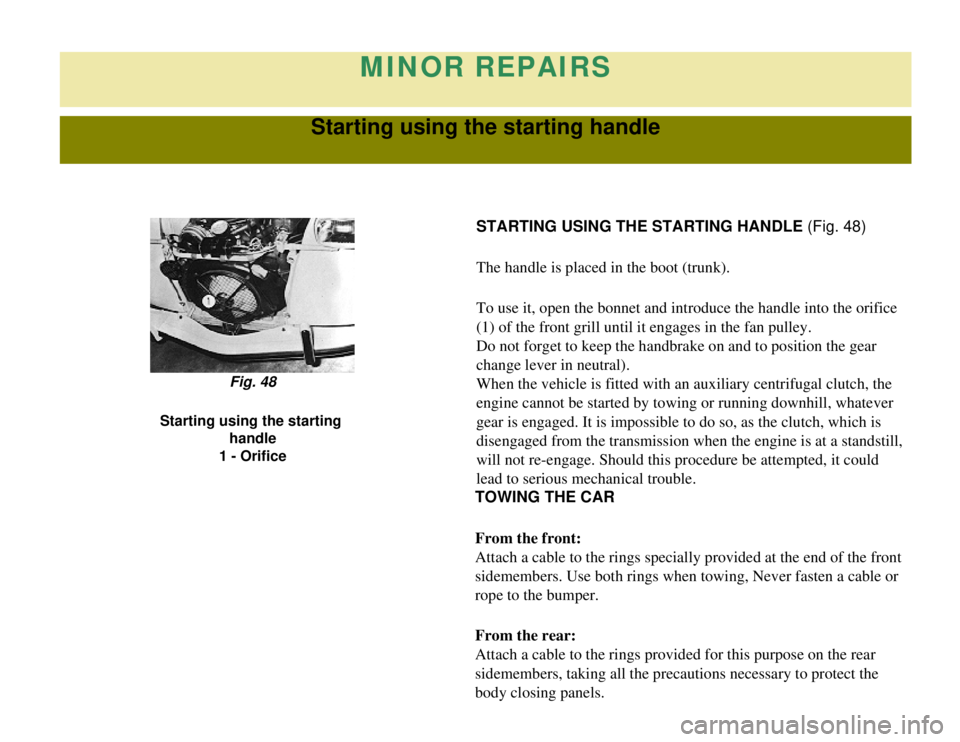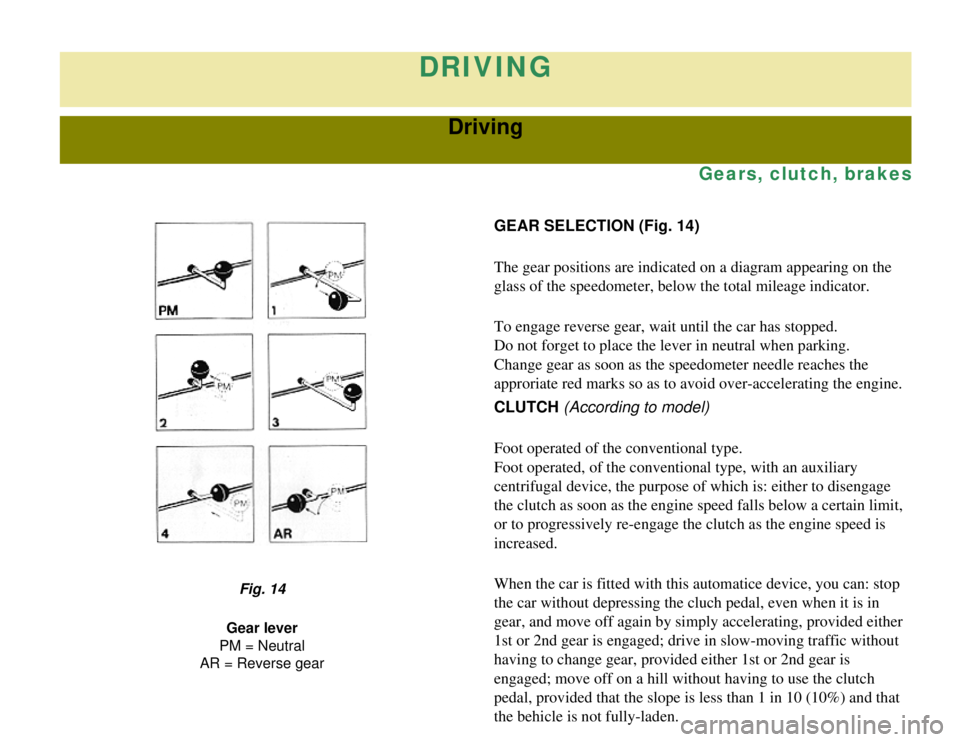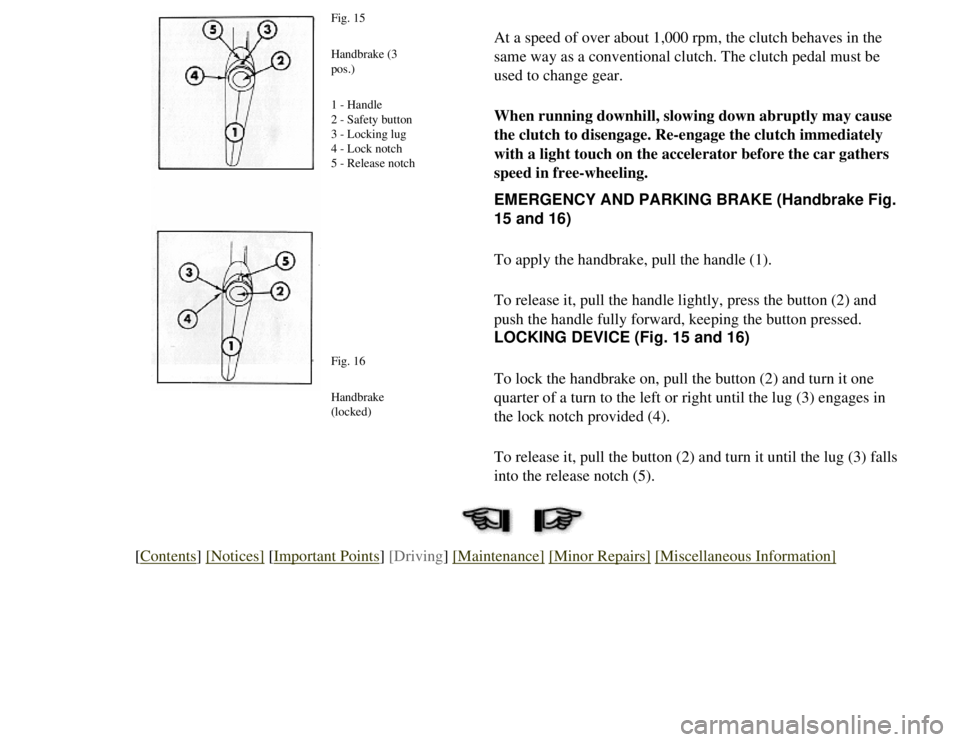Page 8 of 86
Seats, rear-view mirrors, seat beltsStarting:
Anti-theft, ignition, starter
Gears, clutch, brakes
Signals and visibility:
Lights, signals, windscreen wipers/
washer
Air conditioning:
Ventilation, heating, de-misting Comfort:
Folding canvas hood
Accessories
07516
JULY 1975
AZ-KB AZ-KA 2 CV4 2 CV6
[Contents] [Notices] [Important Points] [Driving] [Maintenance] [Minor Repairs] [Miscellaneous Information]
Page 45 of 86

MINOR REPAIRS
Starting using the starting handle
STARTING USING THE STARTING HANDLE (Fig. 48)
The handle is placed in the boot (trunk).
To use it, open the bonnet and introduce the handle into the orifice
(1) of the front grill until it engages in the fan pulley.
Do not forget to keep the handbrake on and to position the gear
change lever in neutral).
When the vehicle is fitted with an auxiliary centrifugal clutch, the
engine cannot be started by towing or running downhill, whatever
gear is engaged. It is impossible to do so, as the clutch, which is
disengaged from the transmission when the engine is at a standstill,
will not re-engage. Should this procedure be attempted, it could
lead to serious mechanical trouble.
Fig. 48
Starting using the starting handle
1 - Orifice
TOWING THE CAR
From the front:
Attach a cable to the rings specially provided at the end of the front
sidemembers. Use both rings when towing, Never fasten a cable or
rope to the bumper.
From the rear:
Attach a cable to the rings provided for this purpose on the rear
sidemembers, taking all the precautions necessary to protect the
body closing panels.
Page 73 of 86

DRIVING
Driving
Gears, clutch, brakes
GEAR SELECTION (Fig. 14)
The gear positions are indicated on a diagram appearing on the
glass of the speedometer, below the total mileage indicator.
To engage reverse gear, wait until the car has stopped.
Do not forget to place the lever in neutral when parking.
Change gear as soon as the speedometer needle reaches the
approriate red marks so as to avoid over-accelerating the engine.
CLUTCH (According to model)
Foot operated of the conventional type.
Foot operated, of the conventional type, with an auxiliary
centrifugal device, the purpose of which is: either to disengage
the clutch as soon as the engine speed falls below a certain limit,
or to progressively re-engage the clutch as the engine speed is
increased.
When the car is fitted with this automatice device, you can: stop
the car without depressing the cluch pedal, even when it is in
gear, and move off again by simply accelerating, provided either
1st or 2nd gear is engaged; drive in slow-moving traffic without
having to change gear, provided either 1st or 2nd gear is
engaged; move off on a hill without having to use the clutch
pedal, provided that the slope is less than 1 in 10 (10%) and that
the behicle is not fully-laden.
Fig. 14
Gear lever
PM = Neutral
AR = Reverse gear
Page 74 of 86

At a speed of over about 1,000 rpm, the clutch behaves in the
same way as a conventional clutch. The clutch pedal must be
used to change gear.
When running downhill, slowing down abruptly may cause
the clutch to disengage. Re-engage the clutch immediately
with a light touch on the accelerator before the car gathers
speed in free-wheeling.
Fig. 15
Handbrake (3
pos.)
1 - Handle
2 - Safety button
3 - Locking lug
4 - Lock notch
5 - Release notch
Fig. 16
Handbrake
(locked)
EMERGENCY AND PARKING BRAKE (Handbrake Fig.
15 and 16)
To apply the handbrake, pull the handle (1).
To release it, pull the handle lightly, press the button (2) and
push the handle fully forward, keeping the button pressed.
LOCKING DEVICE (Fig. 15 and 16)
To lock the handbrake on, pull the button (2) and turn it one
quarter of a turn to the left or right until the lug (3) engages in
the lock notch provided (4).
To release it, pull the button (2) and turn it until the lug (3) fal\
ls
into the release notch (5).
[Contents] [Notices] [Important Points] [Driving] [Maintenance] [Minor Repairs] [Miscellaneous Information]
Page 85 of 86

l Changing a fuse
l Changing a sparking plug
l Changing a wheel
l Charge indicator
l Chassis number
l Chassis number stamping
l Choke
l Clutch
l Controls and accessories (LH) (RH)
D
l Dashboard
l Defrosting
l Demisting
l Dimensions, main
l Direction indicators
l Doors, opening
l Driving position
E
l Engine, data
l Engine, number plate
l Engine, oil level
l Engine, oil, warning lamp
F
l Fuel, filling up
l Fuel gauge
l Fuse boxes
l Fuses
l Rear floor
l Rear hammock for parcels
l Rear-view mirrors
l Reverse gear
l Replacement parts, orders
l Running-costs
l Running-in
S
l Seat belts
l Seats
l Seats, backrest adjustment
l Service at 600 miles
l Signalling
l Sparking plugs and gaps
l Speedometer
l Spots on upholstery
l Starting engine
l Starting engine with handle
l Steering wheel (cleaning)
l Stopping the engine
T
l Tar, removal
l Technical data
l Temperature, interior
l Touching-up paintwork
l Towing the car
l Towing a trailer
l Transmission
l Travelling abroad
l Tyre pressures